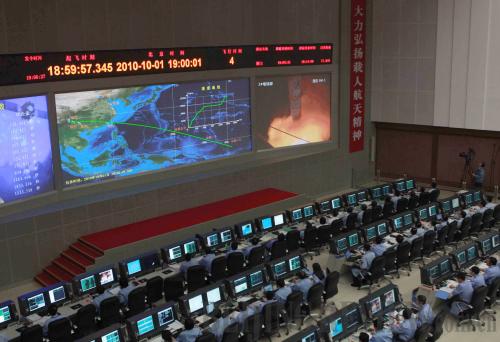|
 |
|
CLOSE MONITORING: In the Beijing Aerospace Control Center, engineers monitor the data on Chang'e 2's trajectory after its launch on October 1 (LIU WEIBING) |
In addition to the ability to orbit closer and a shortened trip to the Moon, the rocket carrying Chang'e 2 has two more boosters than the rocket carrying Chang'e 1, in order to achieve higher accuracy and speed demanded for Chang'e 2 to enter its orbit.
Meanwhile, Chang'e 2 carries a laser altimeter with a range accuracy of 5 meters to obtain more accurate topography data on the proposed landing area for Chang'e 3. The charge-coupled device camera carried by Chang'e 2 will improve photos' spatial resolution from around 120 meters during the Chang'e 1 mission to less than 10 meters.
Chang'e 2's major scientific missions include completing accurate mapping and three-dimensional imaging of the proposed landing area and studying the elements composition and distribution on the Moon, electromagnetic properties of lunar soil, the thickness of lunar soil and the environment close to the Moon. The data will be cross-checked with data obtained by Chang'e 1.
Moreover, an elliptical orbit which Chang'e 3 will travel along will be rehearsed. The orbit's perigee of 15 km from the Moon will create a new record for Chinese lunar probes. According to the requirements of the second stage of China's lunar exploration program, Chang'e 2 has a new X-band control system, enabling China's deep space control capacity to cover the distance between the Earth and the Mars.
Future of resources exploration
As the Earth's only natural satellite, the Moon has records of all geological activities since its formation 4.6 billion years ago. The information will be significant for mankind to learn about the origin and evolution history of the Earth, the solar system and the universe. Moreover, the Moon is rich in energy and mineral resources. Effective detection data collected by Chang'e 1 show the global distribution of the three elements of uranium, thorium and potassium and regional distribution for elements like magnesium, aluminum, silicon, iron and titanium.
Scientists have been working on how to use the resources discovered on the Moon to save the Earth from an impending energy crisis. "There are so many kinds of resources with enormous reserves on the Moon. The titanium alone is distributed in areas as vast as China's territory," said Ouyang. He particularly pointed out the huge reserves of raw materials for controlled nuclear fusion on the Moon. China's lunar exploration program has surveyed and calculated that there are between 1 million and 5 million tons of raw materials in the lunar soil while the world's annual demand is merely 100 tons, which can be transported back with a space shuttle.
The first two stages of China's lunar exploration program cost less than 2 billion yuan ($299 million) in total, of which the first stage spent around 1.4 billion yuan ($209 million). "The expense for the first stage only equals that of building 2 km of subways in Beijing or less than 20 km of high-speed railway between Beijing and Shanghai," said Long Lehao, who was the chief designer for Long-March 3 rockets.
China is the third country in the world to build rockets carrying manned spacecraft. Long said that China needs to develop a new generation of carrier rockets. "Usually it takes around six years to develop a brand-new rocket. Thus the maiden flight of the new generation of carrier rockets is expected to materialize in 2015," said Long.
Chinese scientists believe that China's lunar exploration program is part of the human cause of peacefully using the universe. Wu said that China has carried out international cooperation with other countries and is willing to expand the cooperation. He said the European Space Agency (ESA) has offered China assistance in controlling orbiting satellites while in return China has provided its scientific data to the ESA free of charge. "But we have to rely on ourselves to develop better technologies," Wu said.
Phases of China's Lunar Exploration Program
China's lunar exploration program is divided into three stages: orbiting, landing and recovery.
In Stage One, which started in 2004, China developed and launched its first lunar probe satellite to orbit the Moon. During this stage, the main tasks were to study the lunar topography and mantle, elements and material composition, lunar soil properties and Earth-Moon space environment.
In Stage Two, which is around 2013, an unmanned vehicle will be sent to land on the Moon to explore and examine the topography, geological structure and material composition of the landing area and begin the Moon-based astronomical observation.
The program is expected to enter Stage Three before 2020, featuring the landing of an automated lunar vehicle on the Moon to collect rock samples and bring them back for analysis and research.
(Source: Xinhua News Agency) | 